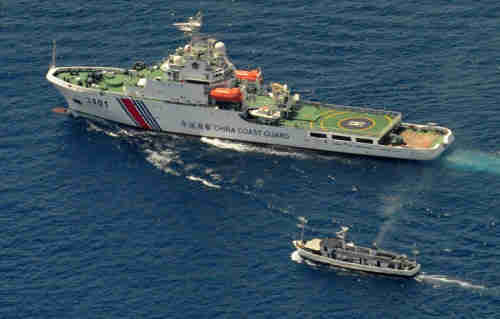This morning’s key headlines from GenerationalDynamics.com
- Philippines and Vietnam launch military and legal buildup to confront China
- China’s Achilles’ Heel — the law of the sea
- China: Vietnam and Philippine militaries are no match for China
Philippines and Vietnam launch military and legal buildup to confront China

The Philippines aims to buy two frigates, two helicopters, and three gunboats for deployment in the South China Sea. South Korea, Spain,
France, Italy and Indonesia are bidding on the contracts to supply the weapons.
India is planning to sell to Vietnam several warship — four patrol boats at first, with seven more later. The sale of these warships has strategic implications for India as well as Vietnam, since India has oil drilling blocks off the coast of Vietnam. New Delhi TV and Reuters
China’s Achilles’ Heel — the law of the sea
China continues a massive military buildup in the South China Sea, even going so far as to build an artificial island to use for its air force. But on the legal front, China continues to hide behind bluster.
Outside of China, there are few international law experts who believe that China’s South Sea China claims, or their notorious “nine-dash-line” doctrine, have any basis in modern international law, specifically the United Nations Convention on the Law of the Sea (UNCLOS). China has been nothing but evasive in response to arbitration procedures in front of the UN Arbitral Panel in the Hague, initiated by the Philippines in 2013 and later joined by Vietnam and supported by the United States. China has refused to recognize any form of arbitration, and last week missed an important deadline in submitting a statement of defense to the panel. No one seriously believes international law will affect China’s vast military operation in the South China Sea, but for the time being, the law of the sea is an embarrassment to China. Straits Times (Singapore) and National Interest and VOA
China: Vietnam and Philippine militaries are no match for China
According to an analysis by China’s military, the countries of the South China Sea are no match militarily for China, but among them, Vietnam is the strongest, followed by Malaysia and the Philippines.
- Vietnam: In order to secure the islands that China is threatening, the Vietnamese military needs to adopt two defensive approaches. First, it must establish a defensive system by combining field and permanent fortifications and building both combat and living facilities. Second, it must form a defensive system by building dotted defensive facilities such as water chalets and bunkers.
- Malaysia: Starting in August 1983, Malaysia dispatched its Marine Corps to occupy South China Sea reefs and islands belonging to
Malaysia, and since then has developed some of them into a famous tourist resort. To adapt to the battle need in the South China Sea,
Malaysia has energetically intensified its naval submarine construction and bought two Scorpène-class submarines and the retired
French submarine Agosta in succession. However, Malaysia is very careful in striking a balance between the territorial disputes over
islands and reefs in the South China Sea and the multilateral friendly relations. - Philippines. The Philippines, with weak economic and military strengths, can barely sustain low-intensity battles. So it employs a
different tactic: It’s migrated hundreds of civilians and a few dozen soldiers to the islands and reefs that belong to the Philippines. On
one of the islands, there are only four soldiers and a simple wooden barrack. A Philippine warship visits the island once every month to
send supplies and rotate soldiers, who use M-16 assault rifle and grenades. What the Philippines has in mind is to accelerate its
military modernization on the one hand, and further merge into the military system established by the US in the Asia Pacific on the other hand, so as to leverage on American forces. - Brunei: Since independence in 1984, Brunei has claimed sovereignty of Nantong Reef at the south end of the South China Sea, but has no military presence in the South China Sea.
KEYS: Generational Dynamics, China, South China Sea, Philippines, Vietnam,
United Nations Convention on the Law of the Sea, UNCLOS,
Malaysia, Brunei, India

COMMENTS
Please let us know if you're having issues with commenting.